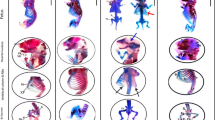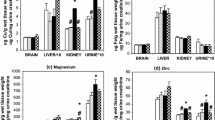Abstract
The present study was carried out to evaluate the effects of sodium selenite on fetal development and DNA in liver of rats. Pregnant rats were divided into three groups: control group, group treated orally with 5 µg Se/kg body wt. and group treated orally with 10 µg Se/kg body wt. Dams were treated orally with sodium selenite from day 7 to 19 of gestation. Sodium selenite treatment revealed decrease in maternal body weight, reduction in fetal weight, length and number of viable fetuses, increased number of resorbed fetuses and post-implantation loss at the two doses tested. Fetal skeleton showed signs of developmental delay in skull and limbs of the treated groups. Sodium selenite treatment revealed significant reduction of placental and liver weights in treated dams. Sodium selenite-induced oxidative stress in liver tissue of rats as evidenced by increase in lipid peroxidation and glutathione peroxidase activity, while catalase was significantly decreased. Also, increase in DNA fragmentation, marked reduction of hepatic DNA content, and many histopathological changes in the liver were recorded. The results demonstrated that treatment of pregnant rats with sodium selenite at the toxic dosages chosen showed maternal and fetal toxicity that may be concerned with hepatic oxidative stress accompanied with DNA fragmentation and depletion of total DNA content.






Similar content being viewed by others
References
Ward MA, Neville TL, Reed JJ, Taylor JB, Hallford DM, Soto-Navarro SA, Vonnahme KA, Redmer DS, Reynolds LP, Caton JS (2008) Effects of selenium supply and dietary restriction on maternal and fetal metabolic hormones in pregnant ewe lambs. J Anim Sci 86:1254–1262
Spallholz JE (1994) On the nature of selenium toxicity and carcinostatic activity. Free Radic Biol Med 17(1):45–64
Usami M, Tabata H, Ohno Y (1999) Effects of ascorbic acid on selenium teratogenicity in cultured rat embryos. Toxicol Lett 105:123–128
Teh SJ, Deng X, Teh FC, Hung SO (2002) Selenium-induced teratogenicity in Sacramento splittail (Pogonichthys macrolepidotus). Mar Environ Res 54:605–608
Papp LV (2007) From selenium to selenoproteins: synthesis, identity, and their role in human health. Antioxid Redox Signal 9:75–806
Rotruck JT, Pope AL, Ganther HE, Swanson AB, Hafeman DG, Hoekstra WG (1973) Selenium: biochemical role as a component of glutathione peroxidase. Science 179:588–590
Kim IY, Kim TS, Chung YW, Jeong D (2007) Selenium-induced apoptosis. Selenium. 2nd Edition. Part III pp 379–385. Its Molecular Biology and Role in Human Health. Springer US. doi:10.1007/0-387-33827-6. ISBN: 978-0-387-33826-2 (Print) 978-0-387-33827-9 (Online)
Hays AW (2001) Principles and methods of toxicology. In: Christian MS (ed) Test methods for assessing female reproductive and developmental toxicology (Embryogenesis), Chapter 29, 4th edn. Taylor and Francis, USA, pp 1301–1317
Pletnikova IP (1970) Biological effect and safe concentration of selenium in drinking water. Hyg Sanit 35:176–180
Cummins LM, Kimura ET (1971) Safety evaluation of selenium sulfiide antidandruff shampoos. Toxicol Appl Pharmacol 20:89–96
McLeod MJ (1980) Differential staining of cartilage and bone in whole mouse fetuses by Alcian blue and Alizarin red. Teratology 22:299–301
Paglia DE, Valentine WN (1967) Studies on the quantitative and qualitative characterization of erythrocyte glutathione peroxidase. J Lab Clin Med 70(1):158–169
Aebi H (1984) Catalase in vitro. Methods Enzymol 105:121–126
Ohkawa N, Ohishi W, Yagi K (1979) Assay for lipid peroxides in animal tissues by thiobarbituric acid reaction. Anal Biochem 95:351–358
Raisbeck MF, Dahl ER, Sanchez EL, Belden D (1993) Naturally occurring selenosis in Wyoming. J Vet Diagn Invest 5:84–87
Willhite CC (1993) Selenium teratogenesis: species-dependent response and influence on reproduction. Ann N Y Acad Sci 678:169–177
Puls R (1994) Selenium. In: Mineral levels in animal health. Sherpa International, Clearbrook, BC, Canada, pp 230–234
Beems RB, Van Beek L (1985) Short-term (6-week) oral toxicity study of selenium in Syrian hamsters. Food Chem Toxicol 23:945–947
Opresko DM (1993) Toxicity summary for selenium and selenium compounds, biomedical and environmental information analysis section, health and safety research division. Oak Ridge National Laboratory, Oak Ridge
Usami M, Tabata H, Ohno Y (2002) Effects of methionine on selenium embryotoxicity in cultured rat embryos. Teratog Carcinog Mutagen 22(4):301–308
Favero AM, Weis SN, Stangherlin EC, Zeni G, Rocha JB, Nogueira CW (2005) Teratogenic effects of diphenyl diselenide in Wistar rats. Reprod Toxicol 20:561–568
Weisa SN, Faveroa AM, Stangherlina EC, Manarina FG, Rochaa JB, Nogueiraa CW, Zeni G (2007) Repeated administration of diphenyl diselenide to pregnant rats induces adverse effects on embryonic/fetal development. Reprod Toxicol 23:175–181
Yang G, Yin S, Zhou R, Gu L, Yan B, Liu Y, Liu Y (1989) Studies of safe maximal daily dietary Se-intake in a seleniferous area in China. J Trace Elem Electrolytes Health Dis 3(2):123–130
Shariff MA, Krishnamurti CR, Schaefer AL, Heindze AM (1984) Bidirectional transfer of selenium across the sheep placenta in utero. Can J Ann Sci 64:252–254
Bedwal RS, Bahuguna A (1994) Zinc, copper and selenium in reproduction. Experientia 50:626–640
Yaeger MJ, Neiger RD, Holler L, Fraser TL, Hurley DJ, Palmer IS (1998) The effect of sub clinical selenium toxicosis on pregnant beef cattle. J Vet Diagn Invest 10:268–273
Usami M, Tabata H, Ohno Y (1999) Effects of glutathione depletion on selenite- and selenate-induced embryotoxicity in cultured rat embryos. Teratog Carcinog Mutagen 19(4):257–266
Hafeman DG, Sunde RA, Hoekstra WG (1973) Effect of dietary selenium on erythrocyte and liver glutathione peroxidase in the rat. Fed Proc 32:885 (abstr.)
Li L, Xie Y, El-Sayed WM, Szakacs JG, Roberts JC (2004) Characteristics of selenazolidine prodrugs of selenocysteine: toxicity, selenium levels, and glutathione peroxidase induction in A/J mice. Life Sci 75:447–459
Hoffman DJ (2002) Role of selenium toxicity and oxidative stress in aquatic birds. Aquat Toxicol J 57(1):11
Zhang J, Wang H, Yan X, Zhang L (2005) Comparison of short-term toxicity between Nano-Se and selenite in mice. Life Sci 76(10):1099–1109
Lane HW, Strength R, Johnson J (1991) Effect of chemical form of selenium on tissue glutathione peroxidase activity in developing rats. J Nutr 121:80–86
Zhang Z, Tian Y, Yang X, Xia Y (1998) Effect of dietary selenium on the activities of glutathione peroxidase and deiodinase in rat liver. Wei Sheng Yan Jiu 27(3):209–211
Zhang JS, Gao XY, Zhang LD, Bao YP (2001) Biological effects of a nano red elemental selenium. BioFactors 15(1):27–38
Spallholz JE (1997) Free radical generation by selenium compounds and their prooxidant toxicity. Biomed Environ Sci 10(2-3):260–270
Stewart MS, Spallholz JE, Neldner KH, Pence BC (1999) Selenium compounds have disparate abilities to impose oxidative stress and induce apoptosis. Free Radic Biol Med 26:42
Raideep K, Sucheta S, Satyavan R (2003) Effect of sub-chronic selenium toxicosis on lipid peroxidation, glutathione redox cucle and antioxidant enzymes in calves. Vet Hum Toxicol 45(4):190–192
Misra S, Niyogi S (2009) Selenite causes cytotoxicity in rainbow trout (Oncorhynchus mykiss) hepatocytes by inducing oxidative stress. Toxicology In Vitro 31 (abstract)
Green DE, Albers PH (1997) Diagnostic criteria for selenium toxicosis in aquatic birds: histologic lesions. J Wildl Dis 33(3):385–404
Mu W, Tian Y, Piao J, Gu L, Yang X (2004) Studies on comparing the toxicity between sodium selenite and selenomethionine in rats. Wei Sheng Yan Jiu 33(6):700–703
Wang H, Zhang J, Yu H (2007) Elemental selenium at nano size possesses lower toxicity without compromising the fundamental effect on selenoenzymes: comparison with selenomethionine in mice. Free Radic Biol Med 42:1524–1533
GX L, Hu H, Jiang C, Schuster T, Lu J (2007) Differential involvement of reactive oxygen species in apoptosis induced by two classes of selenium compounds in human prostate cancer cells. Int J Cancer 120(9):2034–2043
Yunfeng Z, Piye N, Zhiyong G, Jin Y, Jing Y, Tangchun WU, Xuemin C (2007) Relationship between reactive oxygen species and sodium-selenite-induced DNA damage in HepG2 cells. Front Med China 1(3):327–332
Zhou N, Xiao H, Li TK, Nur-E-Kamal A, Liu LF (2003) DNA damage mediated apoptosis induced by selenium compounds. J Biol Chem 278(32):29487–29495
Kim YS, Jhon DY, Lee DY (2004) Involvement of ROS and JNK1 in selenite-induced apoptosis in Chang liver cells. Exp Mol Med 36:157–164
Kaur P, Bansal MP (2004) Effect of experimental oxidative stress on steroidogenesis and DNA damage in mouse testis. J Biomed Sci 11:391–397
Drake EN (2006) Cancer chemoprevention: selenium as a prooxidant, not an antioxidant. Med Hypotheses 67:318–322
Letavayov´a L, Vlˇckov´a V, Brozmanov´a J (2006) Selenium: From cancer prevention to DNA damage. Toxicology 227:1–14
Kim YY, Mahan DC (2001) Comparative effects of high dietary levels of organic and inorganic selenium on selenium toxicity of growing-finishing pigs. J Anim Sci 79:942
Xiang N, Zhao R, Zhong W (2009) Sodium selenite induces apoptosis by generation of superoxide via the mitochondrial-dependent pathway in human prostate cancer cells. Cancer Chemother Pharmacol 63:351–362
Author information
Authors and Affiliations
Corresponding author
Rights and permissions
About this article
Cite this article
Helal, M.A.M. Toxicological Study of Sodium Selenite on Fetal Development and DNA Fragmentation in Liver Cells of Pregnant Rats. Biol Trace Elem Res 140, 114–126 (2011). https://doi.org/10.1007/s12011-010-8682-5
Received:
Accepted:
Published:
Issue Date:
DOI: https://doi.org/10.1007/s12011-010-8682-5




